Publicité
Deadlock at Indian Ocean Tuna Commission means decision on fish resources sustainability delayed
Par
Partager cet article
Deadlock at Indian Ocean Tuna Commission means decision on fish resources sustainability delayed
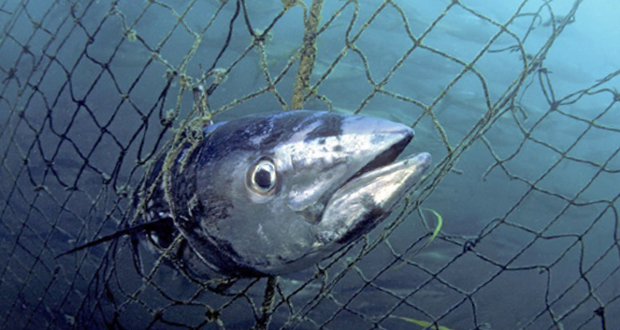
The 30 member-states of the Indian Ocean Tuna Commission (IOTC) were meeting in a special session in the backdrop of alarm over plummeting yellowfin tuna stocks in the Indian Ocean, with conservation groups warning of stock collapse, and an increasing number of European retailers boycotting tuna sourced from the Indian Ocean until a plan to recover stocks is put in place. The bulk of yellowfin tuna stocks in the Indian Ocean are deemed to be overfished.
“We are really disappointed with the lack of progress that we saw this week, we keep seeing the hard decisions that need to be made being delayed from one year to another while the yellowfin tuna stock continues to dwindle each year,” Umair Shahid, Indian Ocean Tuna Manager for the World Wildlife Fund (WWF) tells l’express.
Before the IOTC special session began, two proposals were made to reduce authorised catch limits for yellowfin tuna for the Indian Ocean. The Maldives proposed that these catch limits be reduced to 346,081 metric tonnes. In 2019, an average of 438,000 metric tonnes of yellowfin was caught there.
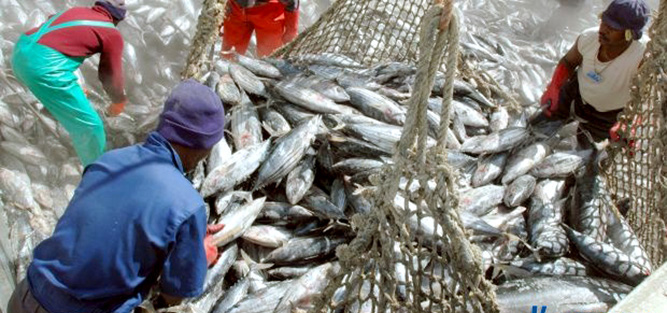
The Maldives position on cuts echoes similar positions held by conservation groups such as the WWF that calls for the authorised catch limit to be reduced to between 340,000 and 350,000 metric tonnes. The Maldives proposal included graduated cuts to different types of fishers in the region, with industrial purse seiners from European and East Asian fleets taking a 35% cut and a 20% cut for gillnet fleets mostly used by coastal states within the region. In contrast, the European Union EU) came up with a more modest cut proposal, calling for catch limits to be reduced to 398,000 metric tonnes.
Different interests
The problem is that the IOTC has been, and continues to be, deadlocked by member-states and stakeholders with different interests and stakes when it comes to yellowfin tuna in the Indian Ocean. Distant water fleets from European and East Asian states account for most of the purse seine catch, which is sold as canned tuna in Europe or sushi in Japan and the United States.
These fleets can move between the Indian Ocean and other regions with tuna stocks, such as the Pacific and the Atlantic. In response to the threat of stock collapse within the Indian Ocean, retailers such as Tesco, Coop and Belgian firm Colruyt announced a boycott of tuna sourced from the Indian Ocean.
The threat of a boycott, however, is not felt as much by coastal states such as Iran, Pakistan, or India, which fish a great amount of tuna, but mostly for domestic consumption and not for export. While yet other coastal states, focused on fishing within their exclusive economic zones or having just recently invested in fishing fleets such as Oman, are less enthused about signing up to cuts in tuna production.

Caught in the middle are the small island states within the Indian Ocean, alarmed by the threat of yellowfin tuna stock collapse within their region while at the same being highly dependent on tuna exports to Europe and Asia for jobs and foreign exchange. Seafood exports, for example, make up nearly a quarter of all Mauritian exports. “The system seems to be broken, there is a disconnect between the countries in the IOTC, they all need to take this bull by the horns now,” argues Shahid.
Shifting positions
Although the IOTC’s special session ended on Friday 12th March without making any decision, its week-long proceedings saw a shift in the positions of certain states with respect to the use of fish aggregating devices (FAD) by industrial purse seiners. These are buoys that attract schools of fish, mostly intended to catch skipjack tuna.
However, they also end up catching large numbers of juvenile yellowfins before they reproduce, threatening the future viability of yellowfin stock in the region. According to estimates, purse seiners in the Indian Ocean have a by-catch rate of 25% as opposed to a global average of 16%. According to a report from the Blue Marine Foundation, 97% of this is made up of juvenile yellowfins.
Earlier this year, 100 NGOs, conservation groups and retailers, including Sainsbury’s, Marks & Spencer and Edeka, urged IOTC states to back a joint proposal by Kenya and Sri Lanka to ban the use of FADs aboard purse seiners for three months each year, between July and September and reducing the authorised number of FADs used by each vessel from 300 to 150. This is not an entirely new stance.
In 2014, for example, Mauritius strongly urged a freeze on FAD use in the Indian Ocean at the IOTC. That proposal was rejected. The current IOTC session, however, saw Maldives switch to backing the proposal from Kenya and Sri Lanka along with several other regional states that switched to calling for better control over FAD use such as Mozambique, Pakistan, Somalia, and South Africa.
The arguments resisting any decisions by the IOTC hinged on a lack of data from artisanal fisheries produced at the session as well as questions about the accuracy of the IOTC’s own scientific estimates and projections of yellowfin tuna populations. This failing from the IOTC attracted the ire of conservation groups.
Following the end of the IOTC’s special session, Jess Rattle, head of investigations at the Blue Marine Foundation, said in a statement, “We heard coastal states describe their fears of social and economic ruin, should the stock collapse; we heard the Maldives beg other members to act now while there is still time, heard Kenya admonish the EU, Korea and Japan for their unwillingness to reduce their use of drifting FADs to save the juvenile yellowfin – all of which fell on the deaf ears of developed, distant water fishing nations and their local flag states of convenience.”
The Blue Marine Foundation said that it will be writing to the UN’s Food and Agriculture Organization (under which the IOTC operates) to improve the workings of its scientific committee.
The problem is that, even if in June the IOTC manages to reach a consensus on how to better manage tuna in the Indian Ocean, any such decision can only be brought into effect 120 days after it is announced, that it well into 2022. Meanwhile, the yellowfin stocks in the Indian Ocean continue to take a battering.
What is driving the yellowfin tuna to collapse in the Indian Ocean?
Yellowfins that can reach sizes of up to 180kg are an apex predator as well as one of the most prized commercial seafood species. In 2019, the global market for canned tuna was estimated at $8.2 billion and is expected to grow by 4.7% each year until 2027. By 2014 alone, tuna made up nearly a quarter of the global seafood market.
The combination of growing demand and the development of fishing technology has led to increased pressure on tuna stocks. Starting in the 1960s, commercial tuna fishing began using purse seiners to catch tuna. However, in the early 1990s, the use of FADs led to dramatically increased catch rates for yellowfins. Until the early 1980s, the average yellowfin catch in the Indian Ocean was between 20,000 and 60,000 metric tonnes. However, by 1993 it had shot up to more than 400,000 tonnes, as more states began using improved fishing technologies to meet growing market and domestic demand for tuna.
The bulk of the fishing in the poorly-regulated Indian Ocean region is done by both coastal and fishing fleets from outside the region.
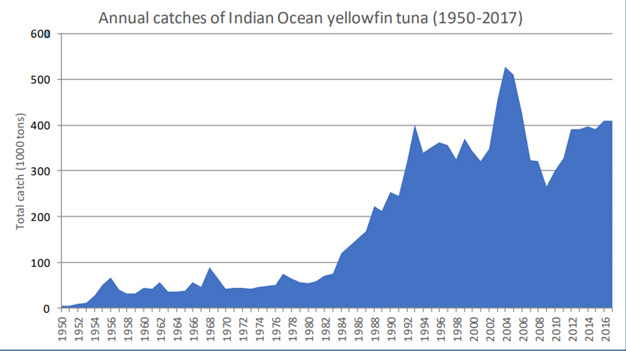
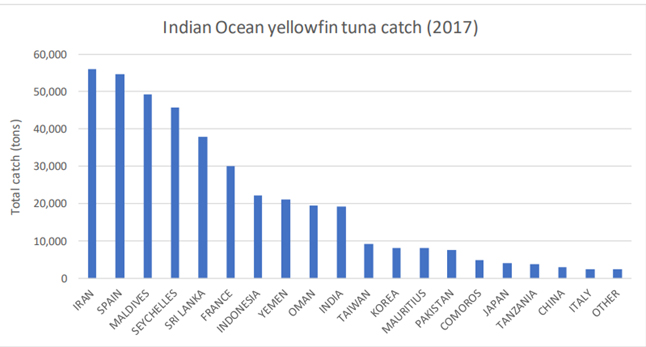
Who are the members of the IOTC?
Founded in 1993, the members of the Indian Ocean Tuna Commission headquartered in Seychelles, are made up of states and regional blocs engaged in fishing for tuna within the Indian Ocean region.
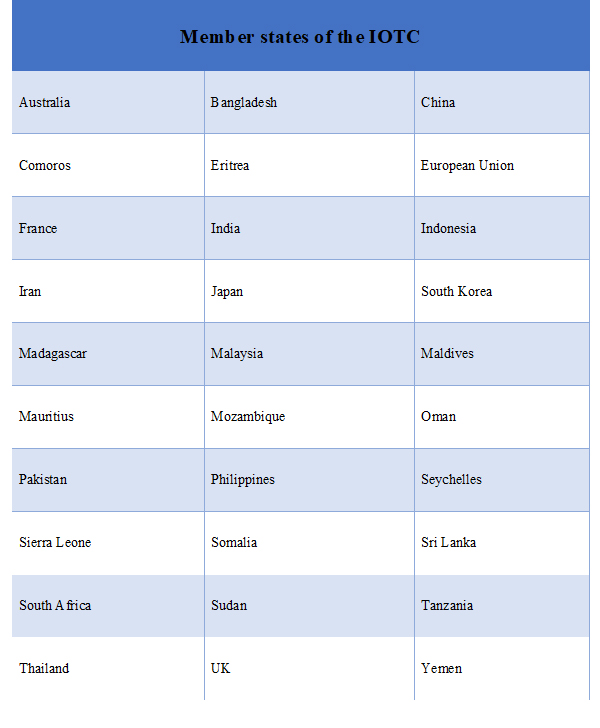
Publicité
Publicité
Les plus récents






